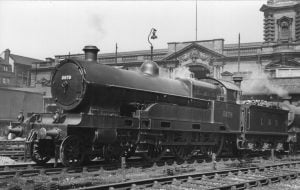Among the last few new build steam projects, we have the LMS Locomotive Trust, who aim to build a replica of London and North Western Railway (LNWR) Claughton Class No.6004 “Princess Louise”.
Unfortunately, the Trust’s website hasn’t been updated recently, with no progress on the build published on their website or social media.
History of the LNWR Claughton Class
The first engine of the Claughton Class, No.2222 “Sir Gilbert Claughton”, was built by Crewe Works on the LNWR in 1913, designed by Charles Bowen Cooke.
Sir Gilbert Claughton was the railway’s current chairman, with Claughton becoming the name of the whole class, a tradition on the LNWR. 130 engines were built between 1913 and 1922.
The class was designed to haul the heaviest and fastest trains on the LNWR, mainly work North of Crewe which was beyond the capabilities of the 4-4-0 classes running on the railway.
The Claughtons featured one design layout which was advanced for its time, this being the four in-line cylinders driving on the leading coupled wheelset. This resulted in no hammer blow being created by the Claughton. Unfortunately, at the time, little knowledge was known about hammer blow, with the Civil Engineer mainly interested in the total weight of the engine and tender. The Claughtons were heavy in overall weight, limiting the routes they could run over, despite doing minimal damage to the track.
Basic dimensions include 4-6-0 wheel arrangement with 6 foot (ft) 9 inch (in) coupled wheels and 3ft 3in bogie wheels, four-cylinder with Walschaerts valve gearing and a tractive effort of 27,072 lbf.
Performance in Service
The Claughtons proved successful locomotives, working top passenger express trains on the LNWR and London, Midland and Scottish Railway (LMS), only being surpassed by the Royal Scot Class in the late 1920s. The class could be seen around most of LNWR, being allocated at sheds such as Camden, Holyhead and Carlisle.

It was found in the 1920s that fitting a bigger boiler would increase the engine’s tractive effort by 2,500 lbf. 20 engines were fitted with new boiler, the main difference being an increase in boiler diameter by 4in from 5ft 1in to 5ft 5in. Half of these received Caprotti valve gearing as a comparison to Walschaerts.
Decline and Withdrawal
With Stanier starting his scrap and build program, the Claughtons were withdrawn in favour of Stanier designed Jubliees and Black 5s. 1937 saw only four left running, the rest scrapped. By 1941, only No.6004, now unnamed, was the last and only Claughton running.
The engine survived another eight years, finally being withdrawn in 1949 under British Railways (BR) ownership due to needing heavy repairs. Although receiving the number No.46004 (BR number), it was never applied. Sadly, No.6004 was broken up and not saved for preservation.
History of the LMS Locomotive Trust
Two retired ex-railway men formed the Trust. The Claughtons were chosen as they are an important missing link in persevered LNWR locomotives.
The opportunity could also be taken to improve the design, which many have done if Bowen Cooke had the time to carry out modification to the design.
Modern design and construction techniques can also be used as well to improve the design to suit modern day running.
For more information or to support the LMS Locomotive Trust, please visit the website here
We have now covered all the new build projects currently in progress!
We here at RailAdvent have put plans together for a new series, similar to the Project Information, and will be starting it next Friday. We may also come back to new build projects that have already been completed or planned.
- Visit the RailAdvent news homepage
For the latest railway news - Visit the RailAdvent Shop
For railway related goodies! - Visit LocoStop – Our New Social Network
Come and share your photo’s and video’s, join the discussion.
Find out what others are sharing